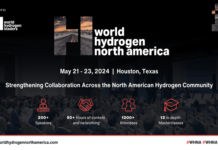Lingao plant has been built to a similar design to the Daya Bay plant, only 1.2km away. Lingao is based on French pressurised water reactor technology. The plant included more local input than its predecessor, which was completed in 1994. The objective of the plant is to meet the growing power demand of south-east Guangdong province with reliable baseload power that does not require the long distance fuel transportation on which the province’s conventional plants depend.
Orders were placed in 1995. Construction of Unit 1 was completed in 2002, with the second following in 2003. Total investment was an estimated $4.1bn.
CHINA AND THE GLOBAL ENERGY INDUSTRY
China’s nuclear power output accounts for only 1.3% of the country’s total, compared with 17% for the world in total. For the future China is looking to the independent development of the nuclear power industry, as it will help to promote the development of high technology industries. Like South Korea, China wants to develop a standard design that can be produced in numbers without resource to international suppliers. The government aims to raise nuclear capacity as high as 20,000MW by 2010 and 50,000MW by 2020.
“China’s government aims to raise nuclear capacity as high as 20,000MW by 2010 and 50,000MW by 2020.”
The Lingao plant is part of China’s 2001-2005 five-year plan, an eleven unit nuclear power development. It is intended that by 2004 nuclear power will provide 8350MW of the total electric capacity. Prior to the Clinton administration, US suppliers were barred from supplying nuclear equipment to China due to safety reasons. China had refused to follow nonproliferation rules set by the International Atomic Energy Act. The other argument to bar Western sales to China was that China exported “dual-use” technology to Iran, Iraq and Pakistan.
It is estimated that China will be the biggest buyer of nuclear technology in the next 25 years. This may be some indicator as to why the US government changed course in their export rulings.
Energy security concerns seen across East Asia are certainly a main driver for nuclear investment. But China is also eager to secure a global role for its fledgling nuclear engineering industry. Chinese groups are regularly engaged in intensive joint venture negotiations with major foreign suppliers, from Westinghouse and AECL of North America to Russian groups. French, Canadian, US, Japanese and Korean technologies and components are all used in the current system. In 1992 China National Nuclear Corporation entered into an agreement with Framatome whereby it would buy water pressurised nuclear power plant technology from the French group. Under the agreement the Chinese were free to buy components from the suppliers of their choice.
This rush to gain knowledge means the emerging Chinese nuclear industry lacks the coherence and standardisation seen elsewhere. This has raised cost and safety concerns. But in the long-term obligatory technology transfers and good experience may give the industry unrivalled engineering expertise. Framatome will bid for work on new nuclear projects in China, but competition became tougher when US groups became free to bid following authorisation from the US Congress.
LINGAO PROJECT FINANCE
Lingao is being completely financed by foreign capital. Electricité de France (EDF) announced that it was prepared to invest FF350m a year in China. This represented a quarter of the equity to be invested by foreign groups in China under the Ninth Five-Year Plan.
BNP managed the pool of banks financing the contracts, which was thought to include West Merchant Bank, the London arm of Germany’s West LB. Export credits were provided by France’s Coface and the UK’s ECGD.
DAYA BAY NUCLEAR PLANT
Daya Bay nuclear plant was shut down 13 times in its first year of operation. Framatome agreed to change parts of the mechanism at Daya Bay that dropped safety rods into the reactors in an emergency, following two failed international safety tests on the speed of drop in one of the two reactors. The problem has not occurred on other Framatome plants and was blamed on a new design of tube that guides the rods into the reactor.
The Chinese ensured that the problems had been fully overcome before signing contracts for Lingao. Environmentalists in Hong Kong have however expressed concern that the Chinese nuclear plants are situated less than 100km away.
NUCLEAR PLANT MAKE-UP
The Lingao order was a major victory for the French grouping of Framatome, GEC Alsthom and EDF. The contract was reportedly worth around $2bn or more. Reactor supplier Framatome took an estimated $1.3bn. GEC Alsthom has said its share for the conventional island was $525m.
“Two units of China’s Lingao plant are now generating a total of 1,870MW, with another two units in construction.”
EDF disclosed no details of its fees for planning, construction and commissioning services. Cegelec, a subsidiary of GEC Alsthom’s 50% parent Alcatel Alsthom, supplied Alpsa P320 process control systems for an estimated $100m. Belgium’s Tractebel Engineering, a long-standing partner of Framatome, provided engineering services. The contracts were won at the price of technology transfer agreements.
LOCAL SUPPLIES
Local suppliers are being extensively involved in the project. LANPC carried out civil works and erection. Dongfang Electrical worked with Framatome on nuclear steam supply systems. Framatome has devoted special attention to this relationship. Dongfang had good nuclear skill potential and, unlike other groups, had no firm nuclear links with other foreign sector players.
Gradually this relationship could simply erode Framatome’s role in China, but the French group aims to maintain its technological edge to protect services and essential component supply business. Investments in local groups and export market partnerships are also not excluded.













































